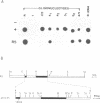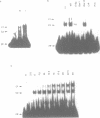Abstract
Proline-rich protein (PRP) gene MP6 was isolated from a mouse BALB/c genomic DNA library in lambda EMBL3, characterised by hybridisation and restriction mapping and the promoter region, from -162 to +72 around the PRP consensus cap-site, was sequenced. In gel shift assays this region formed complexes C1 and C2 with parotid nuclear proteins which were induced by the beta-adrenergic agonist isoprenaline. DNA competition studies and direct binding assays of promoter subfragments showed that it was the sequence from -157 to -91 that was forming the isoprenaline-dependent complexes. All PRP genes conserve a 23bp. sequence, termed PRP Box1, with ets and NFkB/rel binding site-like elements, upstream of their promoters. In the MP6 promoter, PRP Box1 was within the region forming the complexes. Further gel shift assays using PRP Box1 oligonucleotides as competitors and targets indicated that the NFkB/rel binding site-like element was important in formation of the isoprenaline-inducible complexes. HeLa nuclear extracts also formed complexes with PRP Box1 similar to C1 and C2 but nuclear extracts from spleen, submandibular gland and liver did not. These complexes are thus candidate regulators for the isoprenaline-dependent and tissue-specific transcription of PRP genes.
Full text
PDF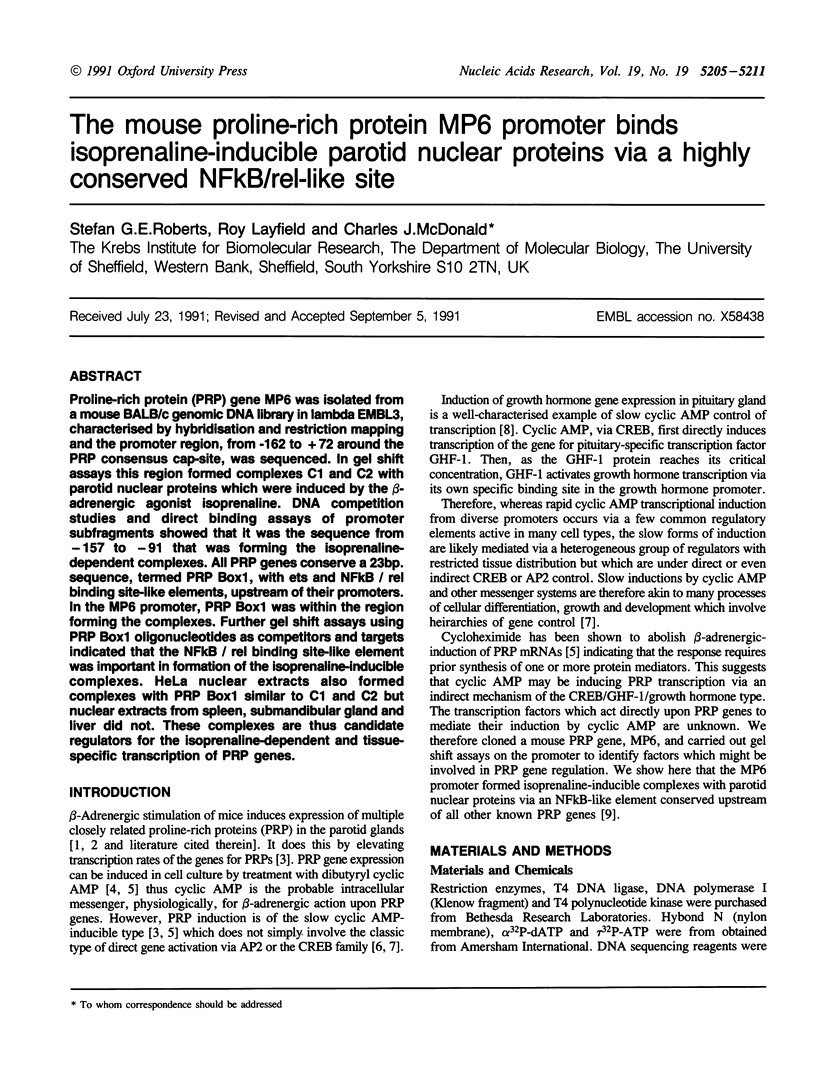
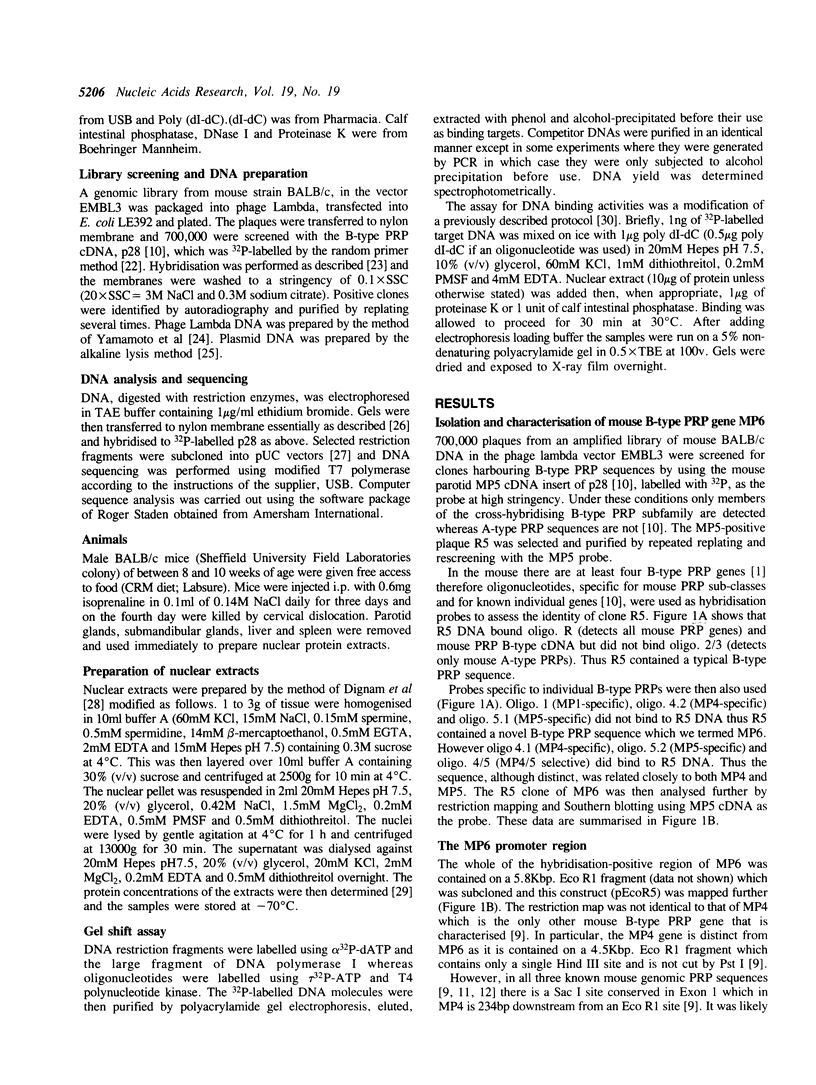
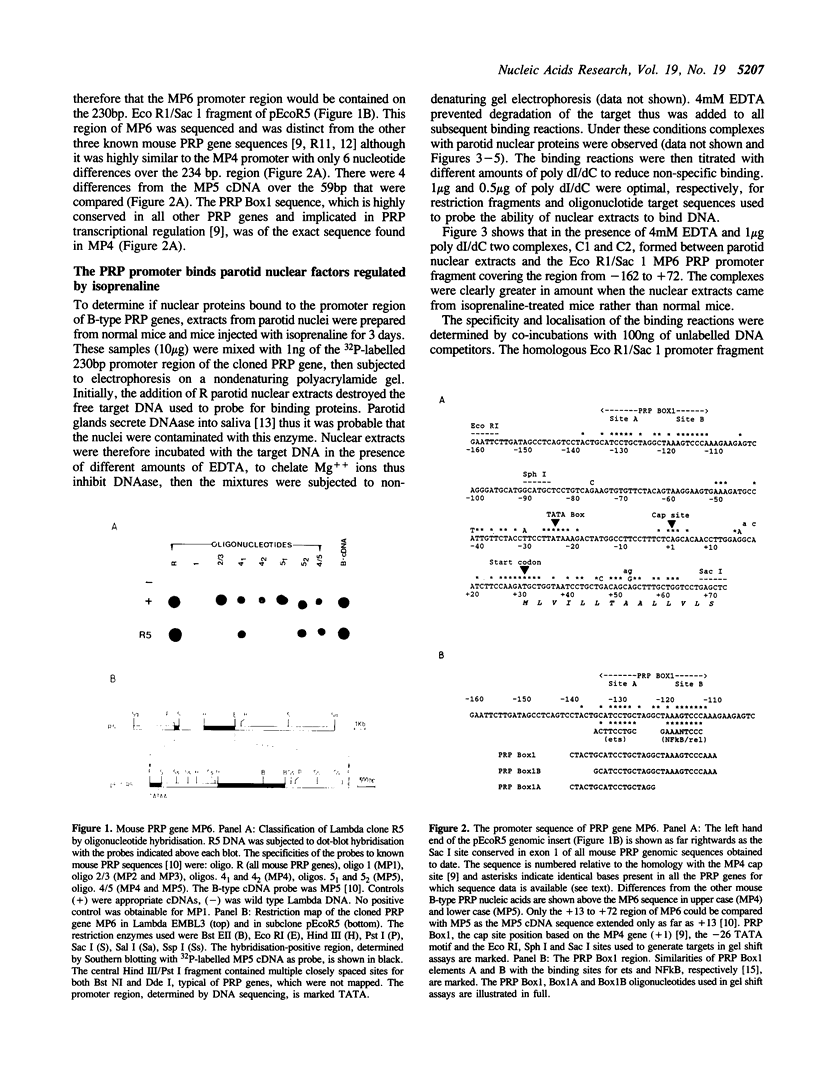
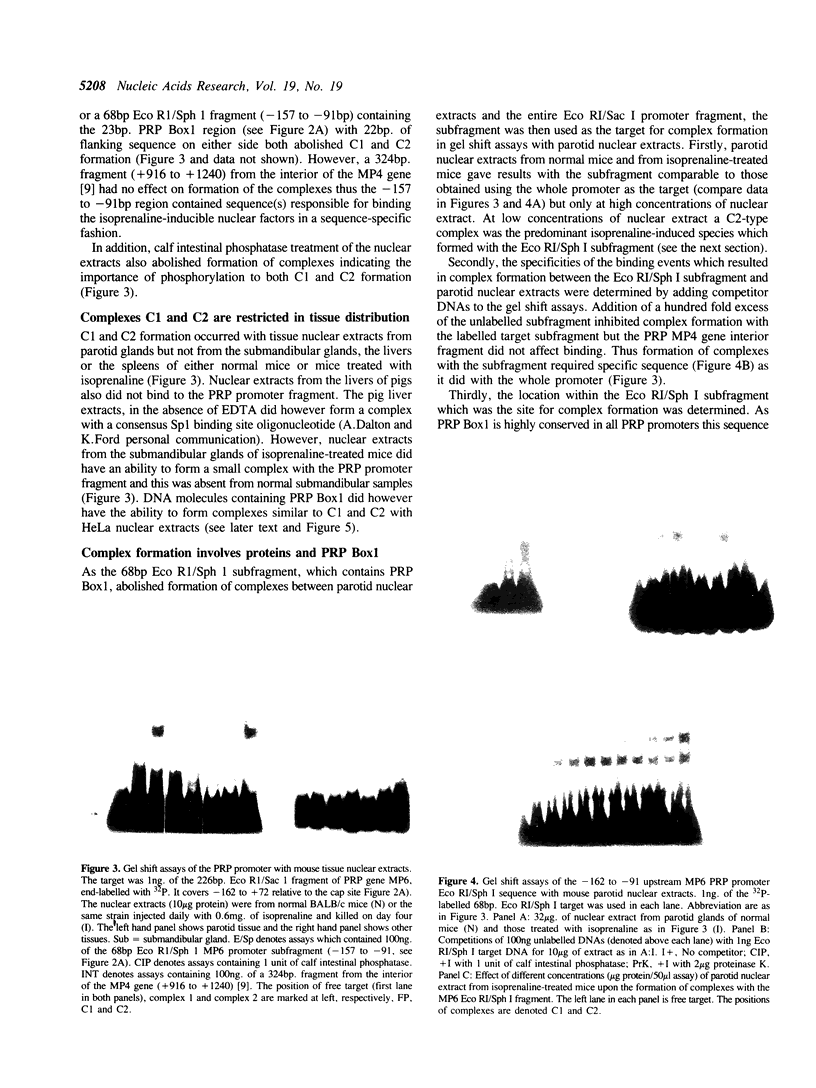
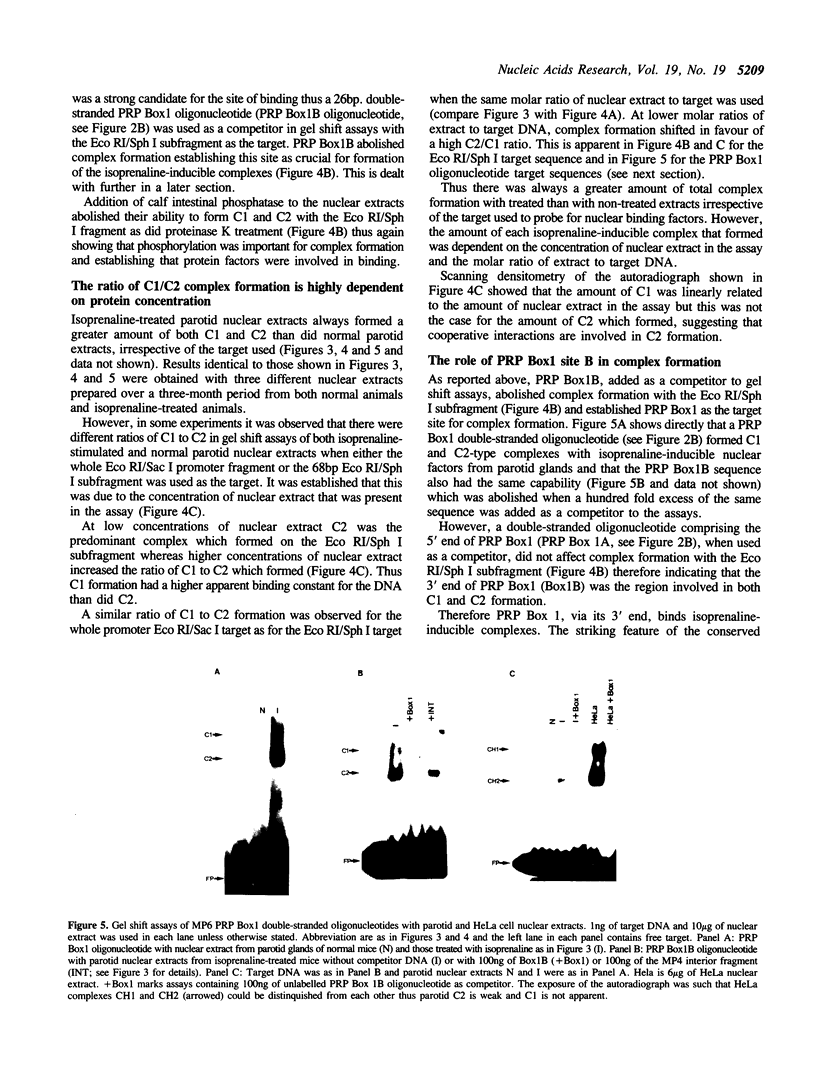
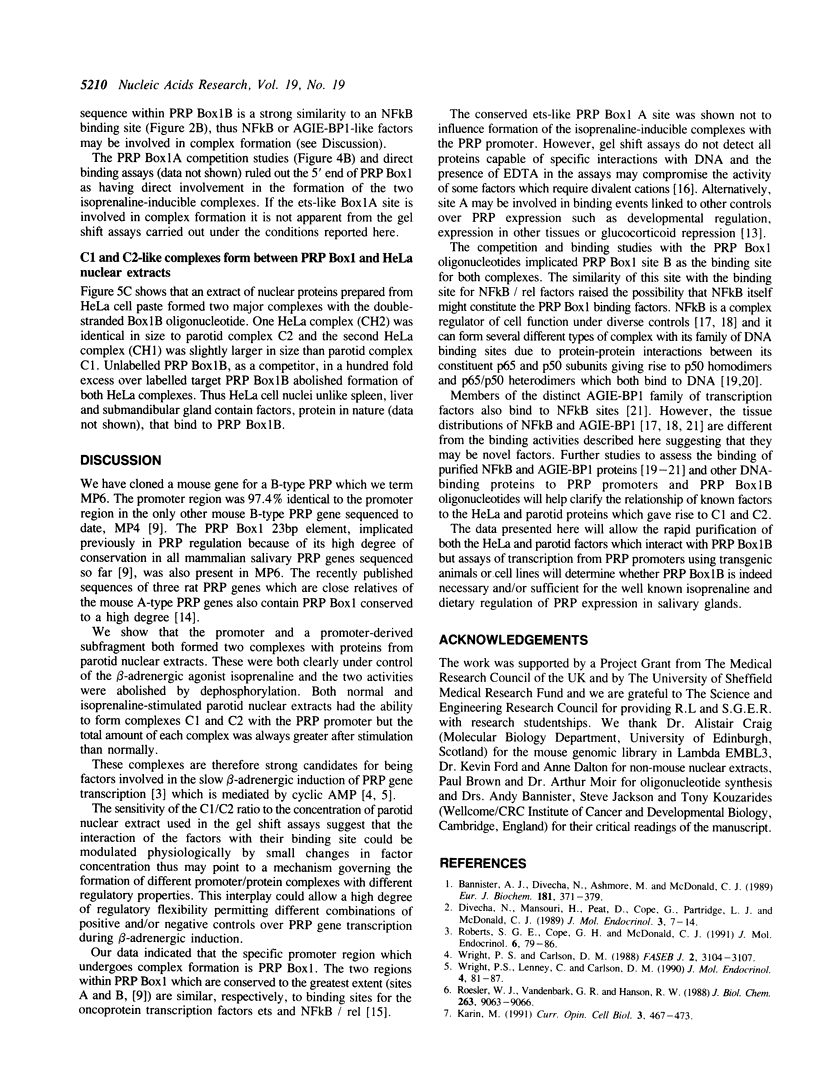
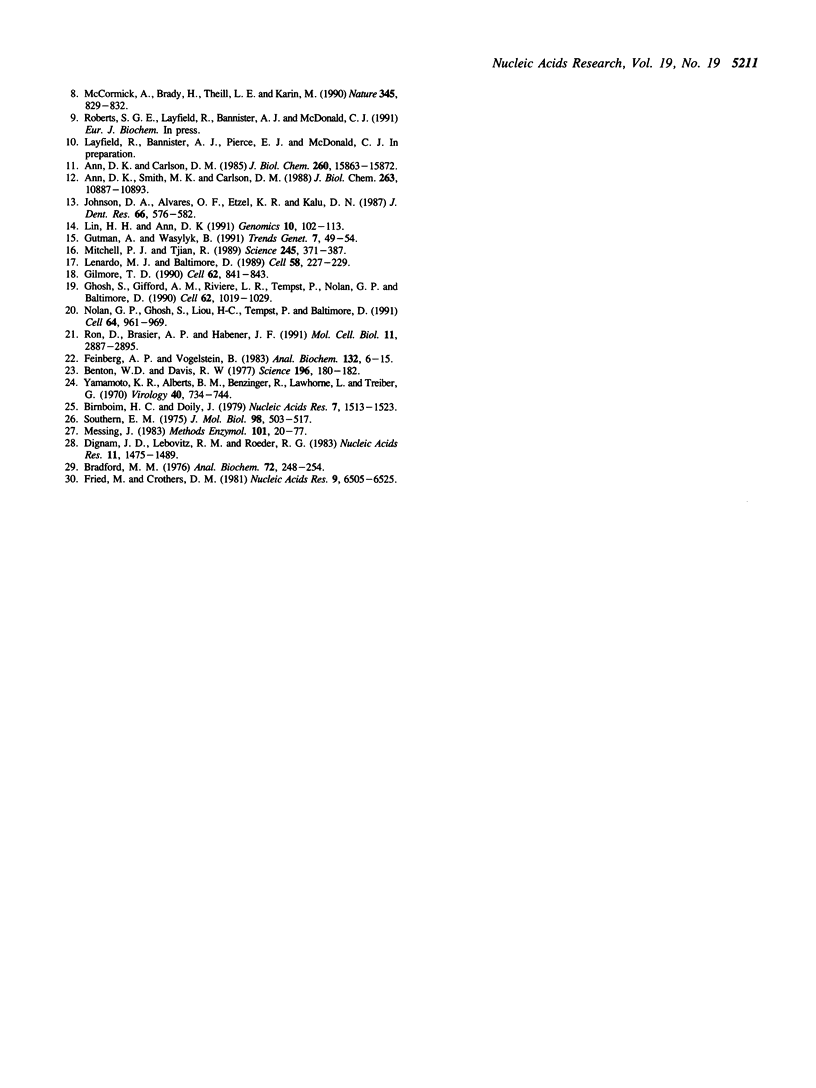
Images in this article
Selected References
These references are in PubMed. This may not be the complete list of references from this article.
- Ann D. K., Carlson D. M. The structure and organization of a proline-rich protein gene of a mouse multigene family. J Biol Chem. 1985 Dec 15;260(29):15863–15872. [PubMed] [Google Scholar]
- Ann D. K., Smith M. K., Carlson D. M. Molecular evolution of the mouse proline-rich protein multigene family. Insertion of a long interspersed repeated DNA element. J Biol Chem. 1988 Aug 5;263(22):10887–10893. [PubMed] [Google Scholar]
- Bannister A. J., Divecha N., Ashmore M., McDonald C. J. Basic proline-rich proteins of murine parotid glands. Induction of mRNA by isoprenaline and post-secretion processing. Eur J Biochem. 1989 May 1;181(2):371–379. doi: 10.1111/j.1432-1033.1989.tb14734.x. [DOI] [PubMed] [Google Scholar]
- Benton W. D., Davis R. W. Screening lambdagt recombinant clones by hybridization to single plaques in situ. Science. 1977 Apr 8;196(4286):180–182. doi: 10.1126/science.322279. [DOI] [PubMed] [Google Scholar]
- Birnboim H. C., Doly J. A rapid alkaline extraction procedure for screening recombinant plasmid DNA. Nucleic Acids Res. 1979 Nov 24;7(6):1513–1523. doi: 10.1093/nar/7.6.1513. [DOI] [PMC free article] [PubMed] [Google Scholar]
- Bradford M. M. A rapid and sensitive method for the quantitation of microgram quantities of protein utilizing the principle of protein-dye binding. Anal Biochem. 1976 May 7;72:248–254. doi: 10.1016/0003-2697(76)90527-3. [DOI] [PubMed] [Google Scholar]
- Dignam J. D., Lebovitz R. M., Roeder R. G. Accurate transcription initiation by RNA polymerase II in a soluble extract from isolated mammalian nuclei. Nucleic Acids Res. 1983 Mar 11;11(5):1475–1489. doi: 10.1093/nar/11.5.1475. [DOI] [PMC free article] [PubMed] [Google Scholar]
- Divecha N., Mansouri H., Peat D., Cope G., Partridge L., McDonald C. J. Isoprenaline-induced and constitutive members of a proline-rich protein sub-group from mouse parotid glands studied with monoclonal antibody NAL1. J Mol Endocrinol. 1989 Jul;3(1):7–14. doi: 10.1677/jme.0.0030007. [DOI] [PubMed] [Google Scholar]
- Feinberg A. P., Vogelstein B. A technique for radiolabeling DNA restriction endonuclease fragments to high specific activity. Anal Biochem. 1983 Jul 1;132(1):6–13. doi: 10.1016/0003-2697(83)90418-9. [DOI] [PubMed] [Google Scholar]
- Fried M., Crothers D. M. Equilibria and kinetics of lac repressor-operator interactions by polyacrylamide gel electrophoresis. Nucleic Acids Res. 1981 Dec 11;9(23):6505–6525. doi: 10.1093/nar/9.23.6505. [DOI] [PMC free article] [PubMed] [Google Scholar]
- Ghosh S., Gifford A. M., Riviere L. R., Tempst P., Nolan G. P., Baltimore D. Cloning of the p50 DNA binding subunit of NF-kappa B: homology to rel and dorsal. Cell. 1990 Sep 7;62(5):1019–1029. doi: 10.1016/0092-8674(90)90276-k. [DOI] [PubMed] [Google Scholar]
- Gilmore T. D. NF-kappa B, KBF1, dorsal, and related matters. Cell. 1990 Sep 7;62(5):841–843. doi: 10.1016/0092-8674(90)90257-f. [DOI] [PubMed] [Google Scholar]
- Gutman A., Wasylyk B. Nuclear targets for transcription regulation by oncogenes. Trends Genet. 1991 Feb;7(2):49–54. doi: 10.1016/0168-9525(91)90231-E. [DOI] [PubMed] [Google Scholar]
- Johnson D. A., Alvares O. F., Etzel K. R., Kalu D. N. Regulation of salivary proteins. J Dent Res. 1987 Feb;66(2):576–582. doi: 10.1177/00220345870660023201. [DOI] [PubMed] [Google Scholar]
- Karin M. Signal transduction and gene control. Curr Opin Cell Biol. 1991 Jun;3(3):467–473. doi: 10.1016/0955-0674(91)90075-a. [DOI] [PubMed] [Google Scholar]
- Lenardo M. J., Baltimore D. NF-kappa B: a pleiotropic mediator of inducible and tissue-specific gene control. Cell. 1989 Jul 28;58(2):227–229. doi: 10.1016/0092-8674(89)90833-7. [DOI] [PubMed] [Google Scholar]
- Lin H. H., Ann D. K. Molecular characterization of rat multigene family encoding proline-rich proteins. Genomics. 1991 May;10(1):102–113. doi: 10.1016/0888-7543(91)90490-6. [DOI] [PubMed] [Google Scholar]
- McCormick A., Brady H., Theill L. E., Karin M. Regulation of the pituitary-specific homeobox gene GHF1 by cell-autonomous and environmental cues. Nature. 1990 Jun 28;345(6278):829–832. doi: 10.1038/345829a0. [DOI] [PubMed] [Google Scholar]
- Messing J. New M13 vectors for cloning. Methods Enzymol. 1983;101:20–78. doi: 10.1016/0076-6879(83)01005-8. [DOI] [PubMed] [Google Scholar]
- Mitchell P. J., Tjian R. Transcriptional regulation in mammalian cells by sequence-specific DNA binding proteins. Science. 1989 Jul 28;245(4916):371–378. doi: 10.1126/science.2667136. [DOI] [PubMed] [Google Scholar]
- Nolan G. P., Ghosh S., Liou H. C., Tempst P., Baltimore D. DNA binding and I kappa B inhibition of the cloned p65 subunit of NF-kappa B, a rel-related polypeptide. Cell. 1991 Mar 8;64(5):961–969. doi: 10.1016/0092-8674(91)90320-x. [DOI] [PubMed] [Google Scholar]
- Roberts S. G., Cope G. H., McDonald C. J. Beta-adrenergic regulation of beta-actin mRNA abundance in mouse parotid glands by a post-transcriptional mechanism. J Mol Endocrinol. 1991 Feb;6(1):79–86. doi: 10.1677/jme.0.0060079. [DOI] [PubMed] [Google Scholar]
- Roesler W. J., Vandenbark G. R., Hanson R. W. Cyclic AMP and the induction of eukaryotic gene transcription. J Biol Chem. 1988 Jul 5;263(19):9063–9066. [PubMed] [Google Scholar]
- Ron D., Brasier A. R., Habener J. F. Angiotensinogen gene-inducible enhancer-binding protein 1, a member of a new family of large nuclear proteins that recognize nuclear factor kappa B-binding sites through a zinc finger motif. Mol Cell Biol. 1991 May;11(5):2887–2895. doi: 10.1128/mcb.11.5.2887. [DOI] [PMC free article] [PubMed] [Google Scholar]
- Southern E. M. Detection of specific sequences among DNA fragments separated by gel electrophoresis. J Mol Biol. 1975 Nov 5;98(3):503–517. doi: 10.1016/s0022-2836(75)80083-0. [DOI] [PubMed] [Google Scholar]
- Wright P. S., Carlson D. M. Regulation of proline-rich protein and alpha-amylase genes in parotid-hepatoma hybrid cells. FASEB J. 1988 Dec;2(15):3104–3107. doi: 10.1096/fasebj.2.15.2847950. [DOI] [PubMed] [Google Scholar]
- Wright P. S., Lenney C., Carlson D. M. Regulation of proline-rich protein gene expression by cyclic AMP in primary cultures of hamster parotid glands. J Mol Endocrinol. 1990 Feb;4(1):81–87. doi: 10.1677/jme.0.0040081. [DOI] [PubMed] [Google Scholar]
- Yamamoto K. R., Alberts B. M., Benzinger R., Lawhorne L., Treiber G. Rapid bacteriophage sedimentation in the presence of polyethylene glycol and its application to large-scale virus purification. Virology. 1970 Mar;40(3):734–744. doi: 10.1016/0042-6822(70)90218-7. [DOI] [PubMed] [Google Scholar]



